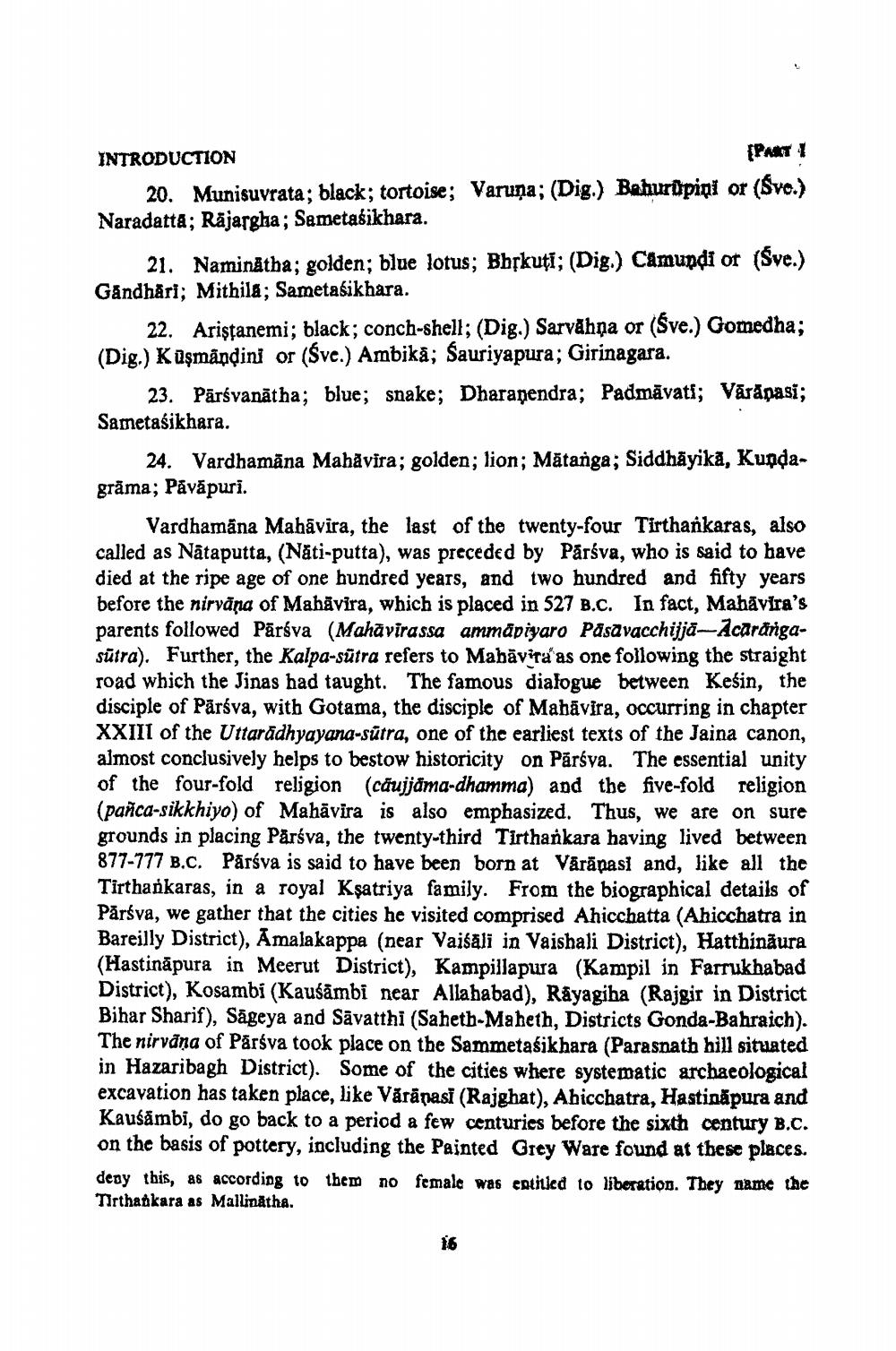________________
INTRODUCTION
[PART 1
20. Munisuvrata; black; tortoise; Varuna; (Dig.) Bahurüpini or (Sve.) Naradatta; Räjargha; Sametasikhara.
21. Naminatha; golden; blue lotus; Bhṛkuti; (Dig.) Camundi or (Śve.) Gāndhari; Mithila; Sametasikhara.
22. Ariştanemi; black; conch-shell; (Dig.) Sarvähņa or (Sve.) Gomedha; (Dig.) Kuşmanḍini or (Śve.) Ambikā; Sauriyapura; Girinagara.
23. Pārsvanatha; blue; snake; Dharanendra; Padmavati; Vārāpasi; Sametaśikhara.
24. Vardhamana Mahāvira; golden; lion; Matanga; Siddhāyikā, Kundagrāma; Pāvāpuri.
Vardhamana Mahavira, the last of the twenty-four Tirthankaras, also called as Nataputta, (Năti-putta), was preceded by Parsva, who is said to have died at the ripe age of one hundred years, and two hundred and fifty years before the nirvana of Mahavira, which is placed in 527 B.C. In fact, Mahāvira's parents followed Pārsva (Mahāvīrassa ammāpiyaro Pasavacchijja-Acarangasutra). Further, the Kalpa-sütra refers to Mahavira as one following the straight road which the Jinas had taught. The famous dialogue between Kesin, the disciple of Pārsva, with Gotama, the disciple of Mahavira, occurring in chapter XXIII of the Uttarādhyayana-sūtra, one of the earliest texts of the Jaina canon, almost conclusively helps to bestow historicity on Parśva. The essential unity of the four-fold religion (căujjama-dhamma) and the five-fold religion (pañca-sikkhiyo) of Mahavira is also emphasized. Thus, we are on sure grounds in placing Parśva, the twenty-third Tirthankara having lived between 877-777 B.C. Parsva is said to have been born at Väräpasi and, like all the Tirthankaras, in a royal Ksatriya family. From the biographical details of Pārsva, we gather that the cities he visited comprised Ahicchatta (Ahicchatra in Bareilly District), Amalakappa (near Vaiśāli in Vaishali District), Hatthinäura (Hastinapura in Meerut District), Kampillapura (Kampil in Farrukhabad District), Kosambi (Kauśambi near Allahabad), Rayagiha (Rajgir in District Bihar Sharif), Sageya and Savatthi (Saheth-Maheth, Districts Gonda-Bahraich). The nirvana of Parsva took place on the Sammetasikhara (Parasnath hill situated in Hazaribagh District). Some of the cities where systematic archaeological excavation has taken place, like Varanasi (Rajghat), Ahicchatra, Hastinapura and Kausambi, do go back to a period a few centuries before the sixth century B.C. on the basis of pottery, including the Painted Grey Ware found at these places. deny this, as according to them no female was entitled to liberation. They name the Tirthankara as Mallinatha.
16




